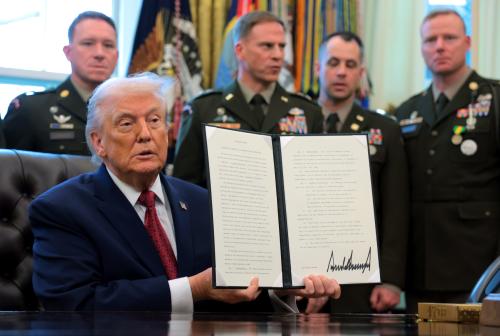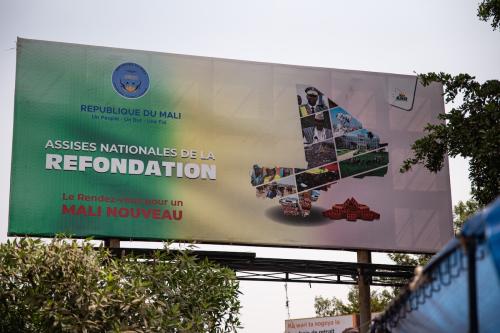Editor’s note: The death of Zimbabwe’s beloved lion Cecil resulted in an immediate outpouring of emotion and raises the question of the state of conservation and trophy hunting. Vanda Felbab-Brown analyzes the issue and suggests that policy specificity and governance are key. This piece is part of the new Africa Security Initiative, an effort organized by the Foreign Policy program at Brookings, in partnership with the Africa Growth Initiative and Global Economy and Development program. The initiative is intended to highlight key issues concerning military, social, and human security in Africa, ranging from crises and conflicts in places such as the Horn of Africa, Central and East Africa, and Nigeria to cross-cutting issues involving illicit economies, terrorism, and other dangers. Learn more »
Yesterday, on Global Tiger Day, an iconic keystone species on the verge of extinction, the media and public were mesmerized by the killing of Zimbabwe’s beloved lion Cecil. Collared for an Oxford University research project and a major tourist attraction, Cecil was killed by a Minnesota dentist, Dr. Walter Palmer, who paid $54,000 for the hunting license. The license turned out to be fake: It is never legal to hunt a collared lion. And worse yet, the lion had been illegally lured out of its protected reserve for the hunt. Palmer claims he is a responsible hunter and was not aware of those violations, for which his Zimbabwean guides have previously been charged in the Zimbabwean court with violating. However, he already has a felony charge for illegally hunting a black bear outside of a permitted area in the United States in 2006.
The outpouring of emotions that has surrounded Cecil’s death will hopefully catalyze a strong international determination and policies to combat the escalating poaching around the world. Wildlife conservation will not necessarily be enhanced, however, by total bans on hunting. While reducing poaching as much as possible needs to be the objective, legal hunting can enhance environmental conservation and even reduce poaching, and sometimes is crucial for accomplishing those objectives. So, moving beyond the emotional reactions to the killing of Cecil, what are the pros and cons of trophy hunting for conservation?
The conservation benefits of allowing trophy hunting
Allowing some level of hunting can, in theory, give hunters, ranchers, and other people close to the wild resource a stake in preserving the species and the entire ecosystem and managing it sustainably. Managed hunting could reduce the pressure on land being converted from its natural state to cattle ranching or agricultural cultivation—a driver of some of the greatest environmental destruction around the world. Often competition for land between landowners and rural populations on the one hand, and wildlife on the other, puts wildlife at great risk, as landowners and rural populations see wildlife as pests and so kill them. Without being able to derive monetary value from wildlife, landowners and local populations may have no stake in any conservation of the species or preservation of the ecosystem. If bans and other restrictions on land use and requirements for conservation impose significant costs on local owners, they may even want to extirpate the species from their lands to avoid such conservation costs. In the United States, the case of the black-footed ferret is example.
In theory, managed hunting, such as trophy hunting, however, puts money in the pockets of landowners legally, perhaps even raising the standard of living of close-by rural populations. Thus, the frequent argument for encouraging the consumption of wild meat or wild plants and for allowing trophy hunting of big animals on private properties in Africa is that this motivates land owners to preserve the ecosystem, instead of burning down the bush for cattle, African oil palm, or other agriculture. For a while in South Africa, where the controlled hunting of the white rhinoceros on private reserves is permitted, the species increased spectacularly. But the positive results of that regime have withered in recent years due to a dramatic escalation of poaching, which has gutted the gains of well-managed licensed hunting.
In an optimal scenario, money raised from trophy hunting would be channeled to underpaid and underequipped rangers so as to increase their capacity and will to combat poaching.
The costs and difficulties of regulating hunting
But many of these presumed positive outcomes often do not materialize, or at least do not fully materialize.
The first issue is whether legal licenses and hunting quotas are handed out wisely and sustainably. A hunting license may be legal and still have disastrous effects on the environment. Just as in any industry—with fishing being perhaps the most emblematic example—lobby groups often pressure governments and international organizations to issue unsustainably high permits, driving species after species to near collapse. Often, only when a species is close to extirpation and placed on the endangered list, will hunting be disallowed. Thus, industry after industry, which presumably has an interest in good management and sustainability, including in trophy hunting, instead eats its own tail and destroys the species. In general, hunting licenses should not be handed out for endangered species and highly restricted for top predators and keystone species on which the health of the ecosystem depends. From an environmental perspective, issuing a hunting license for a zebra or an antelope is much less risky than for a lion or rhino. That said, exceptions could be made: A sick or an old lion that will no longer breed, for example, would be much more appropriate to issue a hunting license for than a young breeding animal.
Trophy hunting can also encourage breeding programs for animals. In parts of Africa, that’s the case even with lions. Sometimes they are bred in rather deplorable conditions in order to keep numbers high enough for a lot of hunting licenses: Their fate is sad for sure. Whether or not such breeding benefits the environment depends on whether wild populations are thriving or being poached even as the breeding programs mass produce animals for legal hunting and whether the rest of the ecosystem is being preserved or logged or grazed down.
The second crucial, but problematic issue is to whom does the money from trophy hunting go: Is it actually spent on the national park and reserve? Does it get into the hands of poor local rural populations? Or is it stolen by government and park officials or captured by few landowners without being actually invested in conservation? Corruption and governance matter hugely.
Corruption is also crucial in the issuing of licenses. If licenses are systematically faked, issued for bribes in excess of quotas, or never checked, the presumed conservation benefits of legal trophy hunting can be nil despite the hefty fee (tens of thousands of dollars) a license could cost a hunter.
Moreover, as with all circumstances where legal trade coincides with an illegal one, licensing complicates law enforcement. It is not easy or straightforward for enforcement to ensure that a legally certified scheme does not serve to launder illegally hunted animals with a fake license or even without one. Just as with total bans on legal trade in wildlife, effective law enforcement is extraordinarily resource-intensive and easily overwhelmed. New technologies, such as DNA testing or microchips for animals in the wild, both of which are being implemented for some species, can reduce law enforcement challenges to some extent, but they are unlikely to eliminate them. Moreover, the tracing often takes place only post facto, once the animal is dead. In addition, for DNA testing to be effective beyond random catches, and to have a large deterrent effect, the database of known genetic samples needs to be enormous, detailed, and complete, since DNA will vary for each specimen. Testing also needs to take place any time the product changes hands.
Finally, permitted trophy hunting may overall encourage demand for such trophies beyond sustainable culling. If licensed hunting is extensively pervaded by illegally obtained licenses, the licensing may serve only to whitewash consumers’ consciousness. Instead of feeling any guilt at all and moderating their demand, consumers may in fact increase their consumption of the supposedly harmlessly obtained product, such as a hunting trophy, and the impact on wildlife may be even worse than if the trade were fully illegal, making it unambiguously clear to hunters and other consumers that they acted illegally and had negatively affected the species and the environment.
And the answer is: Policy specificity and governance
The uneasy bottom line is that there is no one answer, and there should not be one uniform policy as to whether to allow the continued hunting of lions and other trophy hunting, or banning the practice. Policy specificity is key: What needs to be taken into account in deciding whether to permit hunting are the conditions of the species and ecosystem in a particular place; their reproductive requirements; law enforcement capacities to enforce compliance with licenses, or conversely with a total ban; and the likelihood that the money obtained from the license will actually end up in conservation and support better environmental conservation or be stolen by a few. Along with the species biological requirements, conservation success comes down—once again—to effective, enlightened, equitable governance and rooting out corruption.
For further readings on wildlife conservation, check out Vanda Felbab-Brown’s pieces “The Disappearing Act: The Illicit Trade in Wildlife in Asia,” “Indonesia Field Report IV: The Last Twitch? Wildlife Trafficking, Illegal Fishing, and Lessons from Anti-Piracy Efforts,” and “Terrorism, wildlife trafficking, and Obama’s Africa trip.”
The Brookings Institution is committed to quality, independence, and impact.
We are supported by a diverse array of funders. In line with our values and policies, each Brookings publication represents the sole views of its author(s).




Commentary
Getting past the emotions around Cecil the Lion: Hard truths about conservation and trophy hunting
July 30, 2015